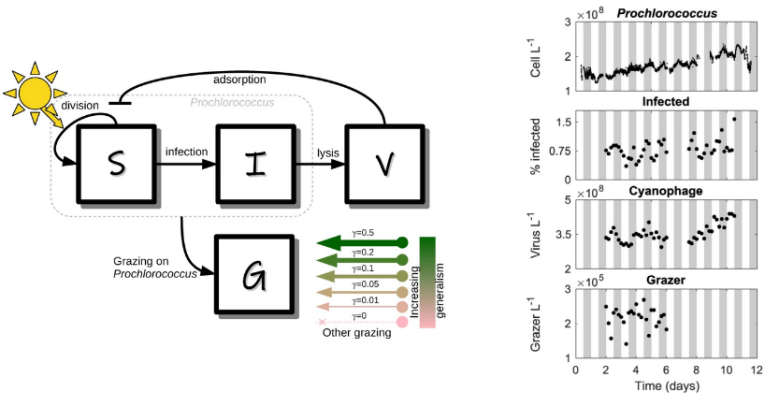A new paper has been published in Nature Communications. Entitled “Disentangling top-down drivers of mortality underlying diel population dynamics of Prochlorococcus in the North Pacific Subtropical Gyre,” the study provides insights into the lifecycle of photosynthetic microbes that drive the base of marine food webs. As shared by the University of Maryland’s Biology Department, “the findings advances efforts to quantify the flow of carbon and nutrients from the surface to the deep ocean.”
The international, collaborative effort was led by Stephen Beckett, associate research scientist in the Weitz Group, and David Demory, a former postdoc with the group who is now a researcher at Centre national de la recherche scientifique in France.
Behind the study: Perspective from co-author and study co-lead Stephen Beckett
This text was originally published on Stephen’s blog.
We have a new paper out in Nature Communications titled: “Disentangling top-down drivers of mortality underlying diel population dynamics of Prochlorococcus in the North Pacific Subtropical Gyre.” For those in the know this has been a long running project, led by myself and David Demory, which has taken multiple years to push out to publication – so we are very pleased to see this published! Our paper focuses on the ecology of Prochlorococcus – the most abundant cyanobacteria in the oceans – with respect to it’s growth dynamics and ecological interactions with grazers and viruses during a cruise in the North Pacific ocean in summer 2015.
Here, we use field population measurements collected on a sampling cruise in the North Pacific in 2015, together with a community ecology mathematical model as the basis for performing model-data integration. Field data was collected over a period of 12 days in summer 2015 following ocean currents just north of Hawai’i. We developed mathematical models of population dynamics to describe the `mechanistic’ ecological interactions between susceptible (S) and infected (I) Prochlorococcus cells, their viruses (V) and grazers (G) to better understand the ecology of this focal cyanobacteria on daily timescales; and additionally we incorporate into our analysis uncertainty about the degree that these grazers diet is specialized for consuming Prochlorococcus. Using Bayesian inference we are able to fit model parameters against the collected field data corresponding to population dynamics of Prochlorococcus, T4- and T7-like cyanophages (viruses of cyanobacteria) that infect Prochlorococcus, and heterotrophic nanoflagellate grazers that predate Prochlorococcus. Our approach does not allow us to distinguish whereabouts heterotrophic nanoflagellate grazers sit on the specialism-generalism spectrum. However, we found consistency when evaluating the relative partitioning of Prochlorococcusmortality — important for considering linkages between the wider ecology and biogeochemistry at this field site. We found that heterotrophic nanoflagellate grazers are estimated to contribute to ~90% of Prochlorococcus losses in this system. We find another ~5% of losses are ascribed to viral-induced lysis by T4- and T7-cyanophage. Importantly, we also estimate another ~5% of losses are not explained by these models, with implications that mortality of cyanobacteria may go beyond just grazing and viral-induced lysis processes as commonly assumed.

Further, we found that model-data fits could be improved by incorporating day/night effects into ecological processes beyond cyanobacterial photosynthesis (in particular the role of viral infection) suggesting light may drive ecological processes at multiple scales. In evaluating our inferred models, we found that the balance between viral-induced lysis and grazing mortality pressures can be sensitive. While we found that Prochlorococcus mortality was predominantly driven by grazing in this system at this time, this trend might not be typical of all marine microbial ecosystems. Indeed, related worksuggests cyanophage infection becomes more important at transition zones north of the Subtropical Gyre. Overall, our work highlights the importance and some of the challenges in disentangling mechanisms underlying marine microbial population dynamics. You can read more in our new paper:
Beckett S.J., Demory D., Coenen A.R., Casey J.R., Dugenne M., Follett C.L., Connell P., Carlson M.C.G., Hu S.K., Wilson S.T., Muratore D., Rodriguez-Garcia R.A., Peng S., Becker K.W., Mende D.R., Armbrust E.V., Caron D.A., Lindell D., White A.E., Ribalet F., Weitz J.S. Disentangling top-down drivers of mortality underlying diel population dynamics of Prochlorococcus in the North Pacific Subtropical Gyre. 2024. Nature Communications 15: 2105.

